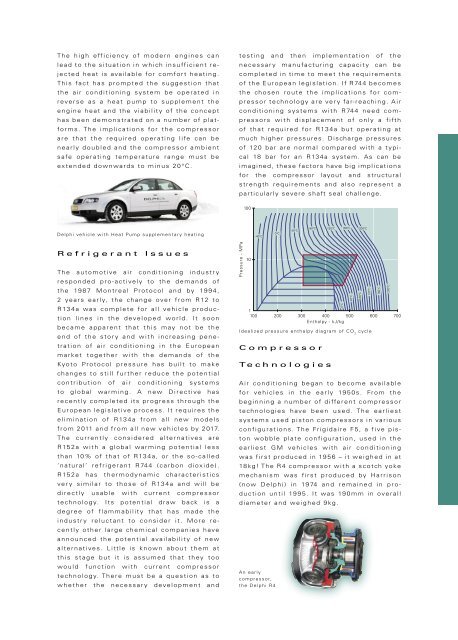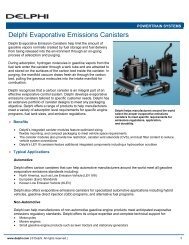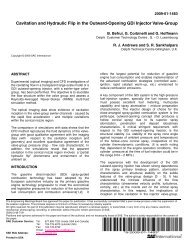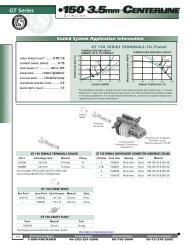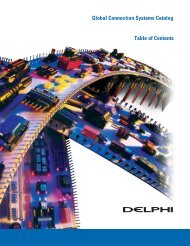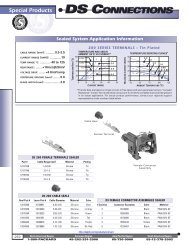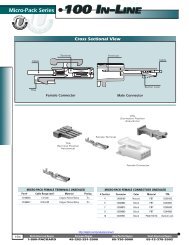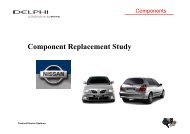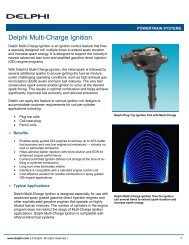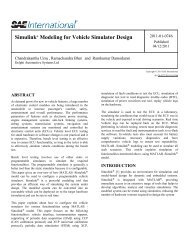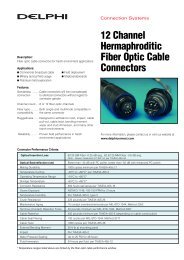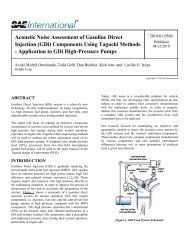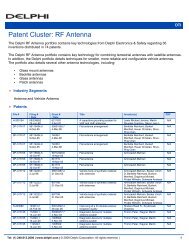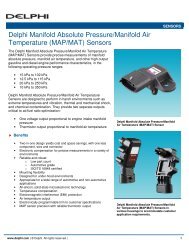Air Conditioning Compressors - Delphi
Air Conditioning Compressors - Delphi
Air Conditioning Compressors - Delphi
Create successful ePaper yourself
Turn your PDF publications into a flip-book with our unique Google optimized e-Paper software.
Th e h i g h e ff i c i e n c y o f m o d e r n e n g ines can<br />
l e a d t o t h e s i tu a t i o n i n which i n s u ff icient re-<br />
j e c t e d h e a t i s ava i l a b l e fo r comfo r t heating .<br />
Th i s fa c t h a s p r o m p t e d t h e s u g g estion that<br />
t h e a i r c onditioning s ys tem b e o p erated in<br />
r eve r s e a s a h e a t p u m p t o s u p p l e ment the<br />
e n g i n e h e a t a n d t h e v i a b i lit y o f the concept<br />
h a s b e e n d e m o n s t r a t e d o n a n u m b er of plat-<br />
fo r m s . Th e i m p l i c a t i o n s fo r t h e c o mpressor<br />
a r e t h a t t h e r e q u i r e d o perating life can be<br />
n e a r l y d o u b l e d a n d t h e c ompressor ambient<br />
s a fe o p e r a t i n g t e m p e r a tu r e r a n g e must be<br />
ex t e n d e d d ow nwa r d s t o minus 20°C.<br />
D e l p h i ve h i c l e w i t h H e a t Pu m p s u p p l e m e n t a r y h e a t i n g<br />
R e f r i g e r a n t I s s u e s<br />
Th e a u t o m o t i ve a i r c o n ditioning industr y<br />
r e s p o n d e d p r o - a c t i ve l y t o t h e d emands of<br />
t h e 19 8 7 M o n t r e a l Pr o tocol a n d by 1994,<br />
2 ye a r s e a r l y, t h e ch a n g e ove r f r o m R12 to<br />
R 13 4 a wa s c o m p l e t e fo r a ll ve h icle produc-<br />
t i o n l i n e s i n t h e d eve l oped wo rld. It soon<br />
b e c a m e a p p a r e n t t h a t t h is m ay n ot be the<br />
e n d o f t h e s t o r y a n d w i th i ncreasing pene-<br />
t r a t i o n o f a i r c o n d i t i o n i n g i n t h e European<br />
m a r ke t t ogether w i t h t he d e mands of the<br />
Kyo t o Pr o t o c o l p r e s s u r e has b u ilt to make<br />
ch a n g e s t o s t i l l f u r t h e r r e d uce the potential<br />
c o n t r i b u t i o n o f a i r c o nditioning systems<br />
t o g l o b a l wa r m i n g . A n ew D i r ective has<br />
r e c e n t l y c o m p l e t e d i t s p r o g r ess t h r ough the<br />
E u r o p e a n l e g i s l a t i ve p r o cess. I t r e q uires the<br />
e l i m i n a t i o n o f R 13 4 a f r om a ll n ew models<br />
f r o m 2 011 a n d f r o m a l l n ew ve h icles by 2017.<br />
Th e c u rrently c o n s i d e r ed alternatives are<br />
R 15 2 a w i th a g l o b a l wa rming p o t e ntial less<br />
t h a n 10 % o f t h a t o f R 13 4 a, o r t h e so-called<br />
‘ n a tu r a l ’ r e f r i g e r a n t R 744 ( carbon dioxide).<br />
R 15 2 a h a s t h e r m o d y n amic characteristics<br />
ve r y s i m i l a r t o t h o s e o f R 13 4a a nd will be<br />
d i r e c t l y u s a b l e w i t h current c ompressor<br />
t e ch n o l o g y. I t s p o t e n t i a l d r aw back is a<br />
d e g r e e o f f l a m m a b i l i t y that h as made the<br />
i n d u s t r y reluct a n t t o c onsider i t. More re-<br />
c e n t l y o t h e r l a r g e ch e m i c al c o m panies have<br />
a n n o u n c e d t h e p o t e n t i a l ava ilabilit y of new<br />
a l t e r n a t i ve s . L i tt l e i s k n ow n a b o u t them at<br />
t h i s s t a g e b u t i t i s a s s u m e d t hat they too<br />
wo u l d f u n c t i o n w i t h c u rrent c ompressor<br />
t e ch n o l o g y. Th e r e m u s t b e a q u estion as to<br />
w h e t h e r t h e n e c e s s a r y d eve l o pment and<br />
testing and then implement ation of the<br />
necessar y manufacturing capacit y can be<br />
completed in time to meet the requirements<br />
of the European legislation. If R744 becomes<br />
the chosen route the implications for com-<br />
pressor technology are ver y far-reaching . <strong>Air</strong><br />
conditioning systems with R744 need com-<br />
pressors with displacement of only a fifth<br />
of that required for R134a but operating at<br />
much higher pressures. Discharge pressures<br />
of 120 bar are normal compared with a t ypi-<br />
cal 18 bar for an R134a system. As can be<br />
imagined, these factors have big implications<br />
for the compressor layout and structural<br />
strength requirements and also represent a<br />
particularly severe shaft seal challenge.<br />
Pressure - MPa<br />
100<br />
10<br />
1<br />
100<br />
-40°C<br />
0°C<br />
200<br />
40°C<br />
80°C 120°C 160°C 200°C<br />
0°C<br />
40°C<br />
300 400<br />
Enthalpy - kJ/kg<br />
500<br />
I d e a l i ze d p r e s s u r e e n t h a l py d i a g r a m o f C O 2 c yc l e<br />
C o m p r e s s o r<br />
Te c h n o l o g i e s<br />
<strong>Air</strong> conditioning began to become available<br />
for vehicles in the early 1950s. From the<br />
beginning a number of different compressor<br />
technologies have been used. The earliest<br />
systems used piston compressors in various<br />
configurations. The Frigidaire F5, a five pis-<br />
ton wobble plate configuration, used in the<br />
earliest GM vehicles with air conditioning<br />
was first produced in 1956 – it weighed in at<br />
18kg! The R4 compressor with a scotch yoke<br />
mechanism was first produced by Harrison<br />
(now <strong>Delphi</strong>) in 1974 and remained in pro-<br />
duction until 1995. It was 190mm in overall<br />
diameter and weighed 9kg .<br />
A n e a r l y<br />
c o m p r e s s o r,<br />
t h e D e l p h i R 4<br />
80°C<br />
120°C<br />
600<br />
160°C<br />
200°C<br />
700


